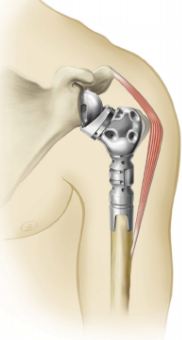Humeral implants designs have changed significantly as a result of improved understanding of prosthetic biomechanics and proximal humeral anatomy. The primary goal of humeral implant design includes the replication of the articular anatomy to restore physiologic soft-tissue tension and to avoid complications such as periprosthetic fracture, aseptic loosening, and proximal humeral bone loss and to provide early implant stability and long-term bony fixation. Trauma is the main reason for humerus fractures. The humerus is mostly fractured due to fall or motor vehicle crash. Physical rehabilitation is also an important part of recovery to regain the use of the upper arm and shoulder. Humerus fractures are of different types depending on the name of the area of bone that is broken. These are proximal humerus fractures, mid-shaft fractures, and distal humerus fractures.
If the bone is moved out of the position, surgery is recommended. Surgery is used to readjust the bone and secure them in a position with surgical hardware, such as pins, plates, wires, and screws. For severe proximal humerus fractures, shoulder replacement surgery is done to remove the injured bone and insert an artificial implant. Both non-cemented and cemented fixation are used, as both techniques have different advantages and disadvantages. Humeral implants have grown from monoblock to modular implants, from diaphyseal to metaphyseal fixation, from press-fit to ingrowth non-cemented designs and from fixed to variable implants.
Humeral Implants Market: Drivers and Restraints
The global humeral implants market is anticipated to register a significant CAGR over a forecast period. The rise in geriatric population and increased number of accidents is anticipated to boost the demand for the humeral implants and drives the global humeral implants market. Changes in lifestyle such as lack of exercise and increased prevalence of obesity in global population are attributing to the weakening of bones, fuelling humeral implants market growth. Increase in the adoption of advanced technologies and ongoing technological advancements also anticipated to drives the global humeral implants market.
However, high complication rates such as aseptic loosening and need of humeral revision associated with the procedures may hamper the demand for the humeral implants and restrain the growth of the global humeral implants market. Additionally, stringent FDA policies for the approval of implants will restrain the growth of humeral implants market.
Request Sample Report @ https://www.futuremarketinsights.com/reports/sample/rep-gb-6002
Humeral Implants Market: Segmentation
The global humeral implants market is segmented on the basis of product type and end user:
- On the basis of product type, the global humeral implants market is segmented into:
- Proximal humerous implants
- Humeral shaft implants
- Distal humerous implants
- On the basis of end user, the global humeral implants market is segmented into:
- Hospitals
- Ambulatory surgical centers
- Clinics
Humeral Implants Market: Regional Outlook
On the basis of regional presence, the global humeral implants market is segmented into seven key regions: North America, Latin America, Western Europe, Eastern Europe, Asia-Pacific excluding Japan, Japan, and Middle East & Africa. Currently, North America is contributing the leading shares to the global systems humeral implants market in terms of value and anticipated to register a significant CAGR over a forecast period. APEJ is also contributing moderate shares to the market due to the newly developed products and growing incidence of injuries is expected to show a robust growth to the global humeral implants market. Europe is the most lucrative market for the humeral implants market. MEA is at a nascent stage to the global humeral implants market and anticipated to register a decent growth to the market over a forecast period. Overall, the global humeral implants market is expected to show significant growth over a forecast period.
Request to View TOC @ https://www.futuremarketinsights.com/toc/rep-gb-6002
Humeral Implants Market: Key Players
Some of the major market players in humeral implants market globally include B. Braun Ireland, Arthrex, Inc., Exactech, Inc., medartis, Zimmer Biomet, Smith & Nephew plc., Stryker, Wright Medical Group, DePuy Synthes and others. These companies are highly focused on the development of advanced humeral implants further contributing to the growth of humeral implants market globally.



